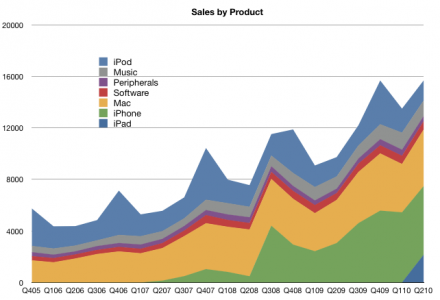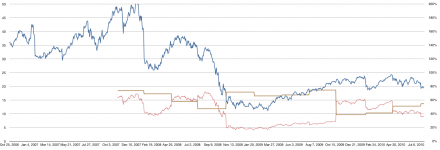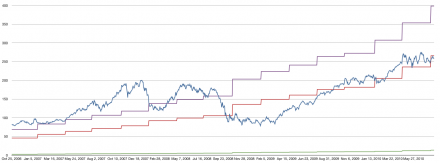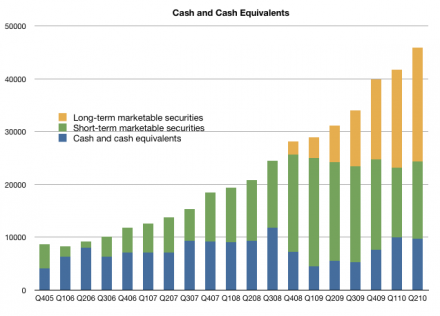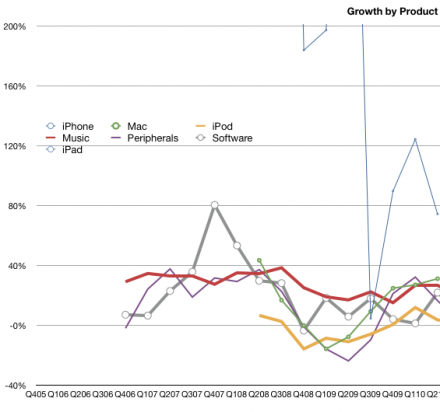The following chart shows the value of sales per quarter (in $million) since the beginning of 2005. What’s interesting to note is that more than half of sales is contributed by products which did not exist three years ago (iPhone and iPad). Music and iPod did not exist 10 years ago. It’s entirely appropriate that Apple removed “Computer” from its name, though they still sell mostly computers of a different kind.
Author: Horace Dediu
Apple's Valuation Struggle Continues
asymco | Apple’s Valuation Struggle.
As despondency over Apple’s 75% earnings growth rate continues, it’s time to revisit the historic P/E in contrast to growth for the company’s earnings.
The latest chart (below) shows the company’s P/E ratio (in blue, left scale) vs. the trailing twelve months rolling growth rate (in brown, right scale) and the ratio between these two (in red, right scale).
The red line can be considered a form of PEG (Price over Earnings over Growth) with the caveat the the Growth is trailing not forward and hence is based on actual data not fictional analyst “consensus”. I call this PETG (Price over earnings over trailing growth).
The actuals show that Apple’s price to trailing growth ratio is dropping to lows unseen since last year when the recession was still in effect. At PETG below 20 the predominant sentiment displayed is extreme pessimism. 100 could be considered an even balance between pessimism and optimism. It now stands at 35.
Apple's Growth Scorecard June 2010
Following up on last quarter’s “asymco | Apple’s Growth Scorecard.”
June quarter showed a significant increase in sales growth (due to the iPad) while the iPhone growth moderated to 74%. Overall earnings growth is a solid green.
AAPL price drops below 20x earnings
Apple vs. Correlation fatigue and the ETF bubble
Recent commentary in financial press (e.g. FT Alphaville » Lost in correlation fatigue and The Herd Instinct Takes Over, Amber Waves of Pain) points out how the markets have become insensitive to fundamentals or valuation itself.
Symptoms of this are:
- Global markets trading in lock-step. In an apparent blindness to any local differences, markets from emerging economies to Japan and to London trade in perfect correlation.
- Crude oil and other commodities are mis-priced due to HFT or algorithmic trading which ignores underlying supply and demand fundamentals.
- Value investors find that there is lack of dispersion among stocks.
- Component stocks’ correlation to the S&P 500 is at highest level since ’87 crash, reaching a high of 83% vs. average of 44% since 1980.
- ETFs (exchange traded funds) maintain (or freeze) over- and under-valuations.
Structural changes such as the proliferation of exchange-traded funds and super-rapid computer-based bloc trading, activities that are totally unconcerned with valuation metrics and/or long-term trends, are still taking place and there is little or no prospect of this development coming to an early end.
- Adam Smith’s invisible hand has for the time being, been handcuffed.
It means you can’t trust any valuation. I could have valued a subprime CDO better on May 6 than any equity. And it’s almost the same thing all day long. Valuations and prices have been divorced for a while. Just look at the volatility. It’s not like traditional trading. No wonder there are such increased correlations.
What this has to do with mobile computing? Interestingly, I find that Apple is not just a victim of this de-coupling of fundamentals from valuation. I hold out hope that the stark facts of its performance might actually pop this correlation bubble.
The hope comes from the fact that trading strategies have finite lives. As soon as a strategy develops to a point of being widely used, it makes sense for a contrarian to “short” or bet on the reverse of that trend, taking advantage of the tendency to overshoot. I don’t have a strong handle on this phenomenon, but the chances are that value/fundamental investment will be back with a vengeance and Apple might just be the leader, by sheer weight of numbers.
Apple's Cash Update
During the last quarter, the company added $4.1 billion in cash to reach a total of $45.839 billion or $49.43 per fully diluted share. This is divided into three types of holdings (long- and short-term marketable securities and cash equivalents).
Some (most?) financial reporting services do not include long-term marketable securities in their databases. This is a tragic error which mis-states most of the balance sheet ratios that investors may depend on. Offending sources include Capital IQ (which feeds finance.yahoo.com.)
To illustrate, the following chart shows the total cash equivalents for the company. The orange colored bars represent long-term securities. If they are excluded, an investor may conclude that Apple’s cash has been *declining* since 2008 when the opposite is true. The company is shifting an increasingly larger proportion of its holdings to long-term (but fully liquid) securities.
The company devotes 9 pages in its 10-Q to describe and value the cash positions it holds. It’s a pity that most aggregators of the company data don’t bother to note $21 billion in assets.
Estimating Fourth Quarter Earnings for Apple
We expect revenue to be about $18 billion compared to $12.2 billion in the September quarter last year. We expect gross margins to be about 35%…
We are targeting EPS of about $3.44.
via Apple Inc. AAPL Q3 2010 Earnings Call Transcript.
That $18 billion figure is extraordinary. Consider that last year during the same quarter, the company received $12.2 billion, then the sales growth forecast is about 50%. Granted that even though Apple just achieved 61% sales growth last quarter, Apple management is unusually aggressive in underestimating.
Given this, I am looking at the following forecast:
- iPhone units: 12.2 million (65% growth)
- Macs: 4 million (30% growth)
- iPads: 3.3 million (flat sequentially, production constrained)
- iPods: 9.4 million (-8% growth)
- Music growth: 26.7%
- Peripherals growth: 21%
- Software growth: 8%
- Total sales: $19.0 billion (56% y/y growth)
- GM: 42.3%
- EPS: $4.78 (73% y/y growth)
If this estimate proves correct, then at the end of the quarter (Oct 1) the trailing twelve months’ earnings per share will be $15.29. That is equivalent to P/E of 16.82 on the back of four quarters of earnings growth (47%, 86%, 75% and 73% respectively). The price/earnings excluding cash would be 13.4.
3Q review: The iPod revenues increase again
The iPod touch increased sales 48% year-over-year. The continuing mix shift toward iPod touch resulted in an overall iPod ASP increase of 12% to $164 (up from $143) generating total iPod revenue growth of 4%.
Units declined 7.9%, inline with my expectations of -8%. I had forecast 9.40 and the actuals was 9.406 million. I note that most amateur analysts over-estimated iPods with my guess being the second lowest. It’s important to consider just how much the iPhone (and iPad) cannibalize the non-iOS iPods.
I am estimating gross margin holding steady at 28%.
Looking forward I am forecasting ASP of 170 and unit growth of -8%.
I’ll also mention here the Music business. Revenues grew at an accelerating 26.7%. This growth is a significant rebound from the 15% to 22% growth of 2009 though lower than the 30%+ range of 2007 and 2008.
3Q review: The iPad adds over $700 million of operating profit with an average selling price of $662
The iPad units numbers were not a surprise (except perhaps to some of the professional analysts who do not read Apple’s press releases). Among the more accurate (amateur) analysts, the range was from 3.2 to 3.45 million with an average of 3.32. My estimate of 3.3 million was the mode of the distribution.
Apple sold 3.270 million in the first ever quarter. The ASP came in at $662.39, below my expected $700 but higher than the iPhone.
The only unknown is the gross margin. Given the overall GM and the other products’ margins, I am backing out a 33% margin for the quarter. I had expected 40% but the lower margin may be a result of launch quarter issues (shipping and allocation of stock) and perhaps a lower target margin for the product. It should be noted that the iPad margin sits between the Mac and iPod (around 30%) and the iPhone (around 60%). The iPad is a new category that sits between the Mac and iPhone in terms of usage and it seems it sits also half-way in terms of margins. Going forward, I’m still modeling a 40% GM for the iPad.
Overall, I estimate the iPad added $717 million of operating profit to Apple’s bottom line. Not bad for a product that was almost universally panned on launch day.
3Q review: Mac units grow 33%
Apple Reports Third Quarter Results.
I was surprised by the poor predictions of Mac units by the analyst community with estimates ranging from 2.86 million to 3.51. It was fairly clear to me early in the quarter that the product would get 30%+ growth. There was little news except overall Mac momentum to shape the forecast and it seemed logical that the growth would stay inline with the last quarter which was 32.8%. I dialed in 33% after the first month and stuck with this so my forecast came out to 3.46 million.
In the event, 3.472 million were sold for a growth of 33.4%. The ASP came in at $1,267, slightly down from $1,278 last quarter and $1,289 the year before. ASPs are eroding but Apple are holding the rate down with product updates. Looking forward, I’m forecast $1,300 ASP.
I estimate gross margin for the Mac at 27%. This is down from 31% a year ago. Revenue growth year-on-year was 31%. The Mac franchise is still doing better than most PC vendors and is gaining share. The graph below shows the growth by product revenues. The Mac is now the second fastest grower after the iPhone (the iPad is not included yet as these are y/y growth rates.)

